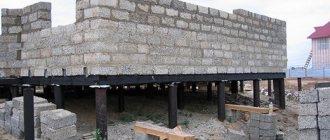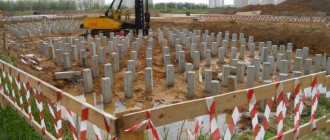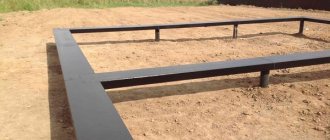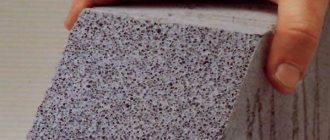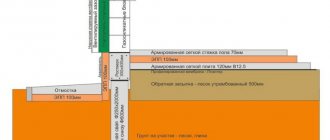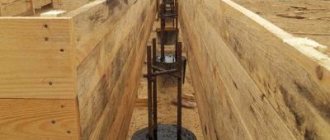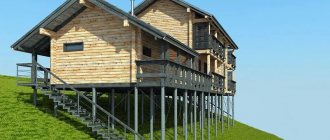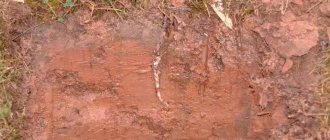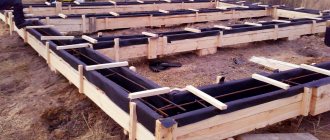You don't know how to build a house on a site with unstable soil? Or is the groundwater at a high level in your area? a pile foundation is perfect for your home . Because it will function perfectly on such soil. In addition, you can make this type of foundation yourself, without hiring professional builders. In this article we will look at the pile foundation for a house, its main types and their features.
What is a pile foundation?
It is a support that takes on the weight of the structure and places it on solid ground with the help of piles immersed in it and a grillage formed on top or a laid foundation slab. The design is illustrated by a diagram of a pile foundation with a grillage.
Basic concepts:
A pile is a key element of a pile foundation, which can be made of different materials. The dimensions are determined by the customer’s needs and can be from 3 to 20 meters long and up to 400 mm. in diameter.
The top piping is the horizontal part of the pile foundation. The task of the upper frame is to fix the piles and redistribute the load of the structure evenly. The piping can be made in the form of a grillage or a foundation slab.
A grillage (grillage strip) is a concrete strip (reinforced concrete frame) that rests on piles, distributing the load from the load-bearing structures of the house. There are monolithic, prefabricated and prefabricated-monolithic grillages.
Foundation slab (grillage slab) - a floor slab laid on the top of the piles. Serves as the foundation for the building.
| Prerequisites for using a pile foundation | |
| Recommended | — with a deep location of dense soil and weak bearing capacity of the top layer of soil (quicksand, peat bog, dusty soil, clay, loess-like soil); — at high groundwater levels; — on heaving soils; — with a significant freezing depth (over 2 m.p.); — in the presence of slopes (including slopes with a steep angle); - for buildings of significant mass (exceeding 350 tons); — if you want to preserve the natural landscape by digging a pit or the impossibility of excavating soil (small size of the plot, no access to the building site, difficulty in storing excavated soil, short construction time, etc.); - if you want to reduce construction costs. |
| Available | - any types of soil |
| Deleted | - soil of rocky pores |
Material prepared for the website www.moydomik.net
Types of grillages
The grillage is not a mandatory structural element. It connects the base supports to each other, giving the structure additional rigidity. There are 3 main types of grillages:
- High . The connecting elements are located above the ground at a distance of 15 cm and above.
- Elevated . The grillage is placed flush with the ground surface or at a height of up to 10 cm .
- Recessed . The grillage is installed below ground level.
Wooden grillage
According to the method of assembly, grillages are distinguished:
- Prefabricated . They are welded steel beams that are used in the construction of lightweight buildings with a short service life.
- Prefabricated monolithic . Elements with “lock” connections. They are used to connect the supports of the foundations of multi-storey buildings and industrial buildings.
- Monolithic . They are single structures in the form of a closed or open tape. They are used in the construction of residential low-rise buildings.
Types and types of foundation piles
The variety of piles, caused by different conditions of their use, can be classified as follows:
| № | Sign | Detailing | Classification meaning |
| 1 | by type of installation | – driven – driven – screw | Helps determine how the pile will be driven into the soil |
| 2 | by nature of work | – supporting – hanging | Helps determine the appearance of the pile |
| 3 | according to material | – reinforced concrete – steel – wooden | Helps determine the number and location of piles |
| 4 | by type of accommodation | – single-standing – formed into pile strips – formed into pile bushes | Helps calculate the number of piles and their installation location |
| 5 | by installation method | – vertical – inclined | Helps determine the number of piles and the method of their installation depending on the bearing capacity of the soil |
Classification is necessary to determine the number and appearance of piles, their location under the building, as well as to determine the need to use technology and its type. Below is a comparative overview of piles and key differences.
By type of installation:
- cast-in-place (bored) piles are manufactured directly at the construction site. To install them, it is necessary to drill wells, reinforce them and fill them with concrete. In private construction, this type of piles is used only for the construction of light buildings;
- driven piles. They are reinforced concrete structures (in rare cases, metal and wood), manufactured in a factory. A distinctive feature is the high load-bearing capacity and the need to use special equipment for driving (pile driving). Immersion depth is up to 20 meters. The use of pile drivers allows the pile to be driven to a sufficient depth and at the same time eliminate the deviation of the pile during the driving process. This type of piles is suitable for the construction of houses of any number of floors and weight;
- screw piles. They are characterized by the presence of a steel spiral wound onto a rod. Screw piles are intended for individual construction. This is due to the fact that the length of the screw pile does not exceed 6 m, which affects its load-bearing capacity. Used for the construction of wooden houses, houses made of foam blocks, aerated concrete and frame buildings. Its popularity among private developers is explained by the fact that the pile can be screwed into the ground yourself.
By type of action:
- support (piles-racks). Racks are used when there is strong soil under weak layers. This type of piles is distinguished by a smooth surface and a wide base. They transfer the load of the house directly to the foundation;
- hanging (friction piles). Piles are used when strong soil is far away and deep excavation is unprofitable or the groundwater level is insignificant. This type of piles is distinguished by a corrugated surface, with which they cling to the soil, thus transferring the load from the house to it.
According to the material:
- reinforced concrete (monolithic or hollow). The estimated service life of reinforced concrete piles is 100 years. They are manufactured in a factory or poured at the site of the pile foundation. The latter option is suitable for individual construction, as it eliminates the use of expensive equipment. This type of piles can be equipped with a screw to simplify installation;
- steel _
For production, a rolled profile or pipe is used. The thickness of the pile wall is 8-12 mm. The market offers options for I-beam piles, box-section supports, etc. A small-section steel pile is strengthened by a tip welded onto the bottom of the pile. To protect against corrosion, steel piles require additional protection. Bitumen, coal tar, and special compounds are used as protective compounds. Steel piles are not widely used due to the following reasons: significant weight (a crane is needed for installation), high metal consumption, and the need for processing;
- wooden _ Wooden piles have a diameter of 220-340 mm and a length of up to 8.5 m.p. Only hard coniferous wood (spruce, pine, larch) is used for production. The runoff (the difference in diameters near the root and crown) is preserved. Today, wood is used extremely rarely due to its susceptibility to rotting and biological activity.
By type of accommodation:
- formed into pile strips. The strip may consist of one or two rows of piles. The task of the structure is to transfer the load of the house to a solid foundation;
- single standing. In this case, the pile is installed under free-standing elements, for example, building columns;
- formed into pile bushes. In this case, the piles are placed in groups. This installation method is chosen in case of weak soil or nearby groundwater. Often, pile bushes are formed in places where significant load is expected, for example, strengthening a large doorway (entrance to a garage).
By installation method:
- vertical. In the vast majority of cases, piles are installed strictly vertically;
- inclined. Used in cases of significant horizontal forces. In particular, if the site has a significant slope and there is a possibility of soil movement, for example, during spring melting of snow or heavy rainfall.
We recommend – technology for constructing a pile foundation (installation features)
Pile classification
Using the soil immersion method:
Comparative diagram of 4 types of piles
- Driven, immersed in the ground without excavating it using pile hammers, vibratory hammers, pile-pressing units.
- Shell piles are buried using vibratory hammers with soil excavation.
- Reinforced concrete drills, installed in the ground by concreting wells.
- Screw metal, screwed into the ground.
Driven reinforced concrete piles are mainly used in mass construction. In some cases, it is permissible to use wooden and metal steel driven piles.
According to the method of support on the ground:
Comparison of piles by method of support on the ground
- Rack piles - rest on rocky and low-compressible layers. The load is transmitted through the heel of the pile.
- Friction piles - rest on compressible layers. The load is transmitted by the side surface and the heel.
Next, we consider the types of piles according to the type of design.
Pile foundation - pros and cons
Among the advantages of a pile foundation are:
- eliminating the risk of building subsidence due to soil heaving or flooding. The piles rest either on solid ground or have a grooved surface, which allows them to transfer the load from the building through the side walls to the soil;
- applicability on almost all types of soils. In this case, the foundation will have reliability, stability and excellent load-bearing capacity. It is recommended to use a pile foundation even in regions with high seismic activity. This is all due to the fact that the piles are resistant to bending and pushing forces;
- reducing the labor intensity of work;
- reducing the consumption of concrete mixture and reinforcing metal;
- a significant reduction in the volume of excavation work, due to the absence of the need to dig a trench or foundation pit. This fact also makes it possible to avoid removing the excavated soil or storing it, as well as without backfilling;
- the possibility of refusing to perform “wet work” when using factory-produced steel or reinforced concrete piles;
- reduction of time costs for foundation construction;
- no restrictions on the time of work. A pile foundation can be installed at any time of the year, incl. in winter. This type of foundation is recommended for use in the northern regions of Russia;
- economical arrangement. Especially in comparison with strip and slab types of foundations.
Among the disadvantages it is worth highlighting the following:
- complexity of communications;
- the impossibility of constructing a basement under a house on stilts;
- the need for careful calculation and design of the pile field. As a rule, this type of work is entrusted to specialists, which leads to additional costs;
- the need to construct a grillage or grillage slab;
- complexity of making the base;
- the need to attract equipment to install piles, deliver and unload them.
Pile-screw foundation.
During its construction, special pipes with a round cross-section and blades are used. They are placed in one or several lines. In order for the foundation to have good load-bearing capacity, it is recommended that after immersing the supports, fill their inner part with concrete.
Pile-screw foundation. Clickable.
So, let us note the main features of the pile-screw foundation:
- firstly, you can immerse the supports into the soil on your own, without the use of special equipment. This advantage is due to the fact that the pipes are equipped with blades. For example, even two people will be enough to immerse the piles .
- short installation time for the base. In particular, installation of the foundation usually lasts up to two days, including manual driving of piles.
-following the immersion of the piles, construction can begin immediately. Here the only condition is the use of beams to tie the foundation .
— the load is evenly distributed when it changes. If load fluctuations occur, the steel supports may move slightly away from the central axis. In other words, they distribute the load more evenly between all supports.
Installation of a pile-screw foundation.
Let's look at the sequence of construction of a pile-screw foundation.
1) Marking points for installing piles.
2) Lubricate steel piles with an anti-corrosion agent.
3) Drilling holes with a depth of no more than 0.7 meters.
4) Screwing the piles into the ground.
5) Control of the level of placement of pile protrusions in relation to the plane.
6) Trimming the tops symmetrically to the horizontal level.
7) Filling the inside of the pipes with concrete.
 Tying the piles with beams or monolithic tape.
Tying the piles with beams or monolithic tape.
Pile foundation tying. Clickable.
What you need to know before starting work:
- the full load created by the weight of the house. The calculation takes into account the static load and a margin of 15-20% for dynamic load and unaccounted loads that may arise in the future. For example, due to the decision to build an attic over the house;
- soil features. To determine its load-bearing capacity, it is advisable to order additional research;
- location of groundwater;
- pile installation step. This parameter is determined during the calculation process based on the above. A step of 2.5-3 m is considered standard for a pile strip foundation. In addition to external load-bearing walls, piles are also located under internal load-bearing walls, at the intersection of load-bearing walls (external and internal), in corners and in places where “heavy” structural elements, columns, fireplaces, etc. are installed.
Submersible in the ground without excavation
These include:
Drivers
Piles of all types are driven into the ground using hammers, vibratory hammers, vibrating or pressing devices.
In other words, driven piles are immersed in the ground under the influence of shock, vibration or dynamic loads; accordingly, the material of driven piles must be designed to withstand the impact of such loads.
In addition, driven reinforced concrete piles with a diameter of ≤ 80 cm and shell piles with a diameter of ≥ 100 cm are further subdivided
By reinforcement method
On piles with non-prestressed and prestressed longitudinal reinforcement, regardless of the presence of transverse reinforcement.
By design features
For solid and composite piles (of several sections).
Note : Driven piles also include reinforced concrete shell piles driven into the ground by vibratory drivers without excavation or with partial excavation of the soil and not filled with concrete mixture.
The classification of driven piles according to geometric characteristics was given above in a separate category.
Printed
This includes concrete and reinforced concrete piles, constructed by placing a concrete mixture in wells. To form wells, the soil is forcibly squeezed out (displaced).
In turn, cast-in-place piles
by device method
divided into
Pressurized, arranged using inventory pipes
The lower end of the pipes of such piles, when immersed in the ground, is closed with a concrete plug or a shoe left in the ground. As the wells are filled with concrete mixture, the pipes are removed.
Stamped, vibration-stamped
Such piles are made by filling punched holes with a rigid concrete mixture. The concrete mixture is compacted with a vibrating stamp in the form of a pipe with a lower pointed end. Well, a vibrating hammer is attached to the pipe.
Stamped in a stamped stock
Cone-shaped or pyramidal-shaped wells are punched into the ground, after which the wells are filled with concrete mixture.
Screw
Piles with a steel or reinforced concrete body (trunk) with a blade (or blades) at the end (Fig. 484.4.5), driven into the ground by screwing, sometimes in combination with indentation.
Screw piles are classified as hanging piles. One of the main advantages of screw piles is the significant widening of the cross-sectional area at the end of the piles, formed by the blade or blades, which not only increases the load-bearing capacity of the piles with a relatively small diameter, but also prevents the piles from being pulled out. Therefore, screw piles were previously used mainly for constructing foundations, to which significant pulling forces are transmitted. Currently, screw steel piles are very often used in the construction of small private houses.
When calculating screw piles, the torque generated during screwing should be taken into account.
Lifetime
The service life of a pile foundation depends on:
- correct choice of pile type and quality;
- accuracy of calculations;
- compliance with installation requirements.
The design life for a pile foundation on reinforced concrete piles is 100 years. On steel piles - about 70. The presence and nature of additional metal processing plays an important role here. For a foundation made of wooden piles - depends on the type of wood and operating conditions.
Metal piles
A rolled profile is used as piles: an I-beam, channel or pipe. Sometimes they are pre-prepared. To do this, weld 2 channels together, thus obtaining a square pipe.
Piles can also be of an open section. They are made by welding corners, rails, I-beams.
Metal is used in cases where it is impossible to install reinforced concrete piles. It is easier to build it up as it goes deeper into the ground.
Metal profiles have high strength, which simplifies their driving into the ground. For a small cross-section, solid inclusions or destroyed rocky soils are not dangerous.
Piles are driven into the ground with a hammer or press. For depths up to 5 m, a hand hammer is sufficient.
Special types of piles among metal products are screw piles. Providing high strength, they are more economical and technologically advanced than reinforced concrete foundations. Piles are hollow pipes with external blades. They are screwed into the soil like screws, preserving its structure and further compacting it. In this case, rotation in the opposite direction is not allowed, so as not to deteriorate the characteristics of the base.
Shell piles application, materials
An effective means of creating a reliable foundation, used in large construction. They serve for a long time. They are rods of large diameter that are empty inside. Standard length is 12 m. Used in the construction of large structures.
Excellent for wet, unstable, weak soils, in the presence of seismic activity, constant vibrations, since they are in close contact with different soil layers throughout their entire length. Installation requires significant space and the use of complex technologies.
Mainly made of reinforced concrete. This allows you to increase their length to 48 meters. Extension is carried out using flange-type connections using bolts. Often supplied with cone-shaped tips. Metal shell piles are ordinary pipes with different cross-sections.
Immersed using special vibration technology. This method in some cases involves the excavation of loosened soil, but you can do without it. The use of such equipment must be coordinated with the relevant authorities, since vibration is dangerous for nearby architectural structures.
